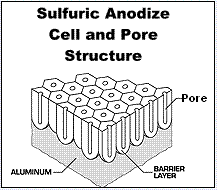Anodizing
|
||
| Anodizing can achieve a wide range of surface finishes from very bright to dull matte in a variety of colors. It can also enhance abrasion resistance, corrosion resistance or reduce surface electrical conductivity. |
||
Finishes achieved are classified into three types:
|
||
| CHROMIC ACID Chromic Acid is most commonly used for corrosion protection under severe service conditions or for a base for paint systems. Not recommended for color anodizing. |
||
| SULFURIC ACID Sulfuric Acid is the most popular electrolyte used for anodizing aluminum due to low electrolyte and operating costs. It is the most conventional and widely used form of anodizing and offers a wide range of finish thicknesses. This finish readily accepts permanent color dyes and offers moderate corrosion and abrasion resistance. Sulfuric color anodizing in unsealed parts is possible because the anodize film has microscopic pores that allow aluminum to absorb dyes through immersion. Typically darker colors require longer anodizing time. After dye immersion, parts must be sealed with nickel acetate to close the pores of the iodize coating to prevent the dye from leaching and the film from deteriorating. Organic dyes are formulated for indoor use and will fade after prolonged exposure to sunlight and the elements. |
||
| HARD COAT Hard Coat anodizing results in a thicker, harder and more dense coating that is abrasion resistant for areas of hard wear. For additional lubricity, a teflon seal may be added. Achieved using higher voltage, a higher acid concentration and longer dwell time than sulfuric, the finish does not accept color readily. The resulting thickness is a combination of 1/2 penetration and 1/2 build up on the surface which makes it difficult to strip. |
||
| CHROMATE CONVERSION COATINGS Chromate Conversion Coatings on aluminum produce a finish that protects the surface from corrosion, assures good paint adhesion, and conducts electricity. Conversion coatings have a generally uniform, indescent light- to dark-gold appearance, or clear. Chem film may be applied to a wide range of aluminum alloys including extrusions, sheet metal, machined stock and castings. MIL-C-5541 is the United States military spec for chemical films for aluminum alloys. |
||
| Call us to discover how to add color to your production process! |
